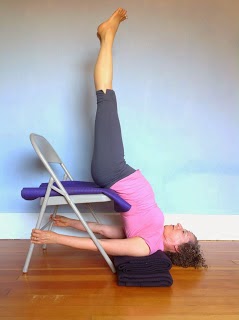
Q: I have developed a very painful shoulder issue. I finally stopped doing shoulder stand, down/up dog, and head stand. I instead switched to “western” solutions, rehab. I am finding that doing Yoga that is not modified for older bodies is dangerous. Is there a form of Yoga that does not require us to drink the Kool-Aid?
A: To answer this question more fully and accurately it would be helpful to know exactly what type of “painful shoulder issue” you have developed (diagnosis) as well as what your current “western rehab program” is like now.
As a physical therapist, when someone in pain comes to see me, I know it is important to try to pinpoint the MAIN area of dysfunction as well as the SECONDARY areas of discomfort. Sometimes the place that hurts the most isn’t the cause of the pain (like painful shoulder) but the pain may be coming from another area of your body. It is very common for neck pain to cause shoulder pain, poor postural habits definitely can cause and exacerbate shoulder pain. Non-ergonomic work stations and driving can also absolutely contribute to painful shoulder as well as recreational activities that you may do, such as rowing for crew, a lot of overhead home repairs, sleep positions and a bed that may be ready for replacement, significant pruning of trees in your garden, backpacking—I think you get the picture.
Usually yoga does not cause pain, but yoga done with structural instabilities and imbalances can exacerbate weak areas and make pain “appear” so we blame yoga for the problem. But the problem is bigger than yoga. My opinion as a yoga teacher and PT is that the teacher doesn’t fit the student to the asana; the asana is there for the student to explore and to find their own release and expansion. In an interview on the Yoga Dork blog Power Your Yoga: Creating Space for Exploring the Present Judith Lasater discusses this very point very eloquently. If you are an experienced student and you know that certain poses cause you difficulties, it is your responsibility to talk to the teacher before class and explain that you have this shoulder problem and if you need to modify a pose it is because you are trying to protect yourself from injury. If the teacher is not agreeable to this plan, then my advice is that you stop practicing with this particular teacher. Now if you are new to yoga and do not feel that you have the experience to modify poses in your class independently, you can ask whether it is possible for you to meet privately so the teacher can teach you ways to modify poses that cause you discomfort or pain.
I always tell my students that I would rather be interrupted in a class to assist a student with a modification than to have that student silently suffering—often their particular issue may also be felt by other students. But some people are too shy to speak up even though the class culture encourages this. (All yoga classes become their own mini ecosystems and there is an exchange and dialogue—not necessarily through words—continuously between students and teachers.)
There are certain rigidities in different styles of yoga that may be less amenable to students who are not all following the same instructions in class. In this instance it might be important for you to stop and reassess why you are studying this particular type of yoga or with this particular teacher. Sometimes it’s not the style of yoga but the particular teacher that you may not resonate with. Again, no one can force you to do a pose that is painful or unsafe for you to do.
I would also recommend that you give the rehab professionals that you are working with pictures of the asanas that are currently difficult for you. They can then break down the poses biomechanically to target specific areas of tightness and weakness that are preventing healthy integrated biomechanics in the performance of the asana.
The poses that you listed as having difficulty with (dog pose, up dog, shoulder stand, headstand) all involve significant weight bearing through the arms, cervical and thoracic spine. Downward-Facing Dog pose has many modifications that you can substitute for the “traditional” pose. For example, if your difficulty with Downward-Facing Dog pose is shoulder range of motion, then it might be better to go back to working with the preparatory position: on all fours, with appropriate shoulder stabilization, torso stabilization, cervical and thoracic neutral positioning and supportive abdominals BEFORE you push up into dog pose. If you are deficient in shoulder range of motion, you might want to practice Half Dog pose at the Wall (or with a table top) to work into stability at 90 degrees shoulder flexion first. Then return to the floor with preparatory Dog, progress to knees off the floor with rocking and then slowly work back into Dog pose using a chair first then returning to the floor. (This progression is difficult to explain without me actually seeing you and watching how you move.)
As to Shoulderstand, a lovely variation is Chair Shoulderstand, which takes almost all the weight off the shoulders, and with a bolster under the shoulders, the head and neck are much less weighted. Headstand is a different problem because even with using a Headstander prop or two chairs to unweight your head and cervical spine, this pose puts a lot of weight into your shoulders. So if the problem is truly from your shoulder, I would recommend that you do not do Headstand until you are pain free or, if the studio where you practice has wall ropes, perhaps you can have your teacher instruct you on how to do the inversion without bearing with through your head or shoulders.
Good luck in your explorations!
—Shari
Follow Yoga for Healthy Aging on Facebook ° To order Yoga for Healthy Aging: A Guide to Lifelong Well-Being, go to Amazon, Shambhala, Indie Bound or your local bookstore.


I am having a similar issue. I have developed arthritis in both AC joints and a possible tear in the supraspinatis. I can't say Yoga practice caused the issue. I do think that trying to "stand" on the shoulders, and getting close to the classic vertical position, has stressed both shoulders. I really don't think we were meant to put all our weight on out shoulder structure. As a senior, I need a system of Yoga stripped of the gymnastic poses, the acrobatic poses.
This is a fantastic article that I discovered just at the right time! I really like your suggestion of bringing in pictures – the physios and osteopaths I've seen in my time don't have knowledge about asana and that would just make the conversation that much easier.
Found your site through J. Brown's blog on "Where did all the yoga blogs go?". Will be avidly following.
Welcome, revolutionary habit! I'm glad you found our blog, and that you enjoyed our recent post. Check out the archives. We've been around for 2 1/2 years!
I recently tore my left deltoid muscle trying a variation of a side arm balance at home (that was clearly beyond my capabilities – but I was simply just bored and thought I'd give it a try). I went to my primary care physician who happens to be of Indian ancestry so when you state the problem in yoga terminology he automatically understands what you did. He explained that the deltoid is the largest muscle in the arm so I was very alarmed when I learned that I may have sacrificed upper arm strength which is much needed in one's 60s and beyond. I had taken over the counter pain relief which had no effect on the problem at all and my physician explained that the over the counter meds weren't working because a tear has very little swelling and there's nothing for an anti-inflammatory to work on. My physician explained that it would probably take a year for the tear to heal and he was precisely right. I didn't stop yoga. I just modified it and took out or modified all poses with significant arm balances. My physician recommended using warm compacts on the arm before exercising followed by cold packs afterwards which I found difficult to do. The point I want to make here is that injury to the deltoid masquerades as a rotator cuff problem. Also, any repetitive lifting, even with light weights seems to cause aching or discomfort in the arm that can radiate to either the neck or down the sides of the ribs on the impaired side of the body. Also, after 18 months following my injury to the deltoid I tried to do cardio at gym with 3 or 5 pound weights and 45 minutes on the treadmill. This was done on a low effort basis. This marvelous idea of mine reinstated the joint weakness in the knee, pain in the low back and caused a flare up of the deltoid discomfort as well as pain in the neck. So here's another really important point -PTs (and that includes physical therapists, as well as personal trainers) and most other rehab personnel who are not yoga practitioners do not really understand anatomy, symptomatology or the central nervous system and besides most of them think yogis are crazy. They treat the pill popping segment of our fine population and cater to employers who want employees to return to work following intensive work hardening regimens. Yoga stopped the residual effects of neck, back and serious knee injuries from the ice skating, tennis and aerobic activities of my youth that included a serious amount of jogging (but no marathons). All of these injuries from overuse returned when I went to the gym and now have to be reversed through resumption of a yoga practice. And – without trying to impress you with my wisdom – I have to share yet one more bit of advice and that is: Any injury caused by or exacerbated by yoga can almost always be cured or ameliorated by modifying your yoga practice – not leaving it. Let me say it again having been a disability lawyer for umpteen years – the PTs and rehab personnel in our medical facilities (and I live in a city dominated by health care giants) are not properly trained in physiology and anatomy. Please evaluate these comments because you definitely need upper torso strength in your senior years and you should be able to do this without surgical intervention notwithstanding what Western medicines uninformed opinions are with respect to your condition.
Thanks for your comments and your personal story of healing. And your point about deltoid muscle tear masquerading as rotator cuff injury is a good one. However, your point about PTs, trainers and such not understanding anatomy and physiology may be true in some cases, but I have worked with many competent, caring PTs and find their knowledge exceptional. Trainers are another story and I won’t comment here on that. Shari Ser, one of our staff writers is firstly a PT and secondly a yoga teacher, and this is becoming more and more common. Sure, the medical care system in this country is broken, but the vast majority of practitioners come to their work with a desire to help others. And as for injury that arises from yoga, yes, there are times that yoga can help with recovery, but not always. I have spoken with many yogis who had to drastically change their practice and let go of some of the postures because they continued to worsen a yoga related injury. Thanks again for you thoughts! —Baxter Bell